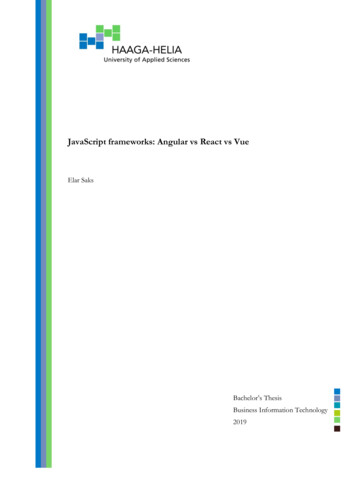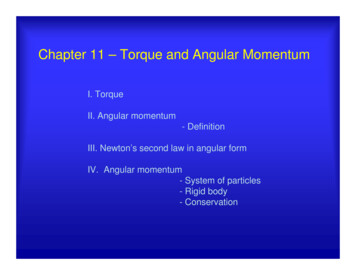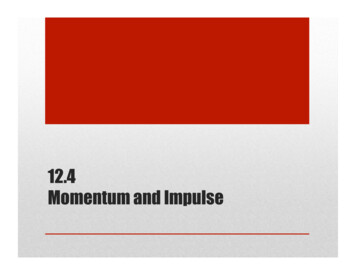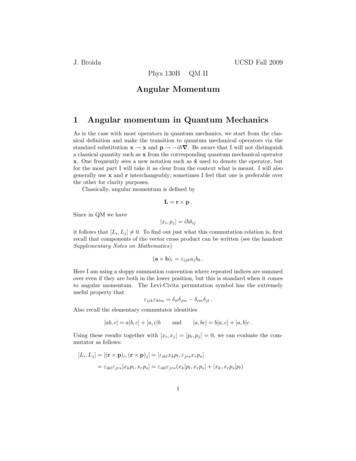
Transcription
Civil Engineering HydraulicsMechanics of FluidsConservation of AngularMomentumReviewIf we look at the angular momentum of a body,we consider the moment or torque thatproduces the rotation The expression is slightly different than forlinear momentum M Iα2Conservation of Angular MomentumMonday, October 1, 20121
ReviewBoth expressions are similar in form but they dodiffer in the units Both expressions do involve vector quantities 3 dϖM Iα Idt dV F ma mdtConservation of Angular MomentumMonday, October 1, 2012ReviewNow we will shift our attention to utilizing theconservation of angular momentum rather thanthe conservation of linear momentum Linear momentum will still be conserved, weare just looking at the system with a slightlydifferent viewpoint dϖM Iα Idt4Conservation of Angular MomentumMonday, October 1, 20122
Angular MomentumIn the same way that in statics when we usedthe sum of the moments equal to 0 we did notviolate the sum of the forces being equal to 0 Now we can consider conserving both linearand angular momentum dϖM Iα Idt5Conservation of Angular MomentumMonday, October 1, 2012Angular MomentumA moment required a force to generate themoment and a moment arm A change in angular momentum requires achange in angular velocity and the moment ofinertia about the axis of rotation If either of these quantities change, then theremust be a corresponding change in themoments or torques acting on the system 6 dϖM Iα IdtConservation of Angular MomentumMonday, October 1, 20123
Angular Momentum A flow with a mass flow rate m and atangential velocity of v (with respect toa circle and a center of rotation), hasa linear momentum along the tangentwhich is equal to the product of themass flow rate and the tangentialvelocity m v7Conservation of Angular MomentumMonday, October 1, 2012Angular MomentumIf this represents a change inmomentum, then a force is generated. The force in turn generates a momentabout any point not on the line ofaction of the force. The moment generated by this forceabout the center of rotation is given by 8 F m v M r F r m vConservation of Angular MomentumMonday, October 1, 20124
Angular Momentum Since we started with a tangentialvelocity the radius vector is normal tothe velocity vector and the magnitudeof the moment can be calculated as F m v M r F r m v M rmv9Conservation of Angular MomentumMonday, October 1, 2012Angular Momentum Tangential velocity can also bedefined in terms of angular velocity F m v M r F r m v M rmvv rω10Conservation of Angular MomentumMonday, October 1, 20125
Angular Momentum 11So the moment can be developed interms of the angular velocity F m v M r F r m v M rmvv rω M rm ( rω ) r 2 mωConservation of Angular MomentumMonday, October 1, 2012Angular Momentum 12Remember that the M is in responseto a change in angular momentum F m v M r F r m v M rmvv rω M rm ( rω ) r 2 mωConservation of Angular MomentumMonday, October 1, 20126
6–73 Water enters a two-armed lawn sprinkler along the vertical axis at arate of 60 L/s, and leaves the sprinkler nozzles as 2-cm diameter jets at anangle of θ from the tangential direction, as shown in Fig. P6–73. The lengthof each sprinkler arm is 0.45 m. Disregarding any frictional effects, determinethe rate of rotation n. of the sprinkler in rev/min for (a) θ 0 , (b) θ 30 , and(c) θ 60 .13Conservation of Angular MomentumMonday, October 1, 2012In order to determine the rate of rotation, n, we will need to find thetangential velocity of any point at a distance, r, from the center ofrotation. The expression relating the tangential velocity and the rate ofrotation is given asn& ω2πwhere n is in radians per minute(rpm).So to solve our problem(s), we will need to be able to solve for theangular velocity.14Conservation of Angular MomentumMonday, October 1, 20127
There is an expression relating angluar velocity to tangential velocity.The expression isω VtangentialrSince we know r, it is given in the problem, we need the tangentialcomponent of the velocity to solve the problem. We need to solve forthe tangential velocity.15Conservation of Angular MomentumMonday, October 1, 2012If we consider the circle developed by the radius of the sprinkler thecontrol volume, we can write out momentum expression for that controlvolume.rr& ) M ( mrVout r& )( mrVinSetting an x-y axis through the center of rotation of the sprinkler we canwrite the velocity as a vector at each jet.16Conservation of Angular MomentumMonday, October 1, 20128
Setting an x-y axis through the center of rotation of the sprinkler we canwrite the velocity as a vector at each jet.The velocity of the jet on each side of the system can be written asshown below. Since the sprinkler arms are opposed to each other wecan set the x-axis along the axis arm.rrrVleft V sin θ i cosθ j(17)rrrVright V sin θ i cosθ j(Conservation of Angular Momentum)Monday, October 1, 2012The change in angular momentum on the left side would be equal to thecross produce of the radius of the sprinkler times the velocity on the leftside times the mass flow rate.rrrleft r irrdHleftr&left rleft Vleft mdtrrrrdHleft&left r i V sin θ i cos θ j mdtrrdHleft&left rV cos θ k mdt( )()(( ) (18Conservation of Angular Momentum))Monday, October 1, 20129
The change in angular momentum on the right side would be equal tothe cross produce of the radius of the sprinkler times the velocity on theright side times the mass flow rate.rrrright r irrdHrightr&right rright Vright mdtrrrrdHright&left r i V sin θ i cos θ j mdtrrdHright&right rV cos θ k mdt()()(() (19Conservation of Angular Momentum))Monday, October 1, 2012Since the mass flow rate is the same from both sides of the sprinklesthe rate of change in momentum change across the system is equal torrrdH dH right dH left dtdtdtrrdH& cos θ k 2mrVdtand in scalar termsdH& cos θ 2mrVdt20Conservation of Angular MomentumMonday, October 1, 201210
We actually have two velocities acting here. The velocity of thenozzle and the velocity of the jet of water as it exits the nozzle. Thisisn't an easy thing to see but it is critical to the problem. If sometorque was accelerating the nozzle, we would need to look at therelative velocity of the point with respect to center of the system.In this case, we know that there are no applied moments on thesystem so we can say that the change in angular momentum is equalto 0.21Conservation of Angular MomentumMonday, October 1, 2012We know that the mass flow rate is not equal to 0 and that the radiusof the sprinkler is not equal to 0 so the relative velocity of thesprinkler to the water must be 0. What this means is the the onlyvelocity component acting on the system is the velocity of the waterexiting the sprinkler.So we can state that the velocity of the sprinkler nozzle is thevelocity of the jet. This also means that the tangentialcomponent of the jet's velocity if the tangential velocity of thesprinkler nozzle.22Conservation of Angular MomentumMonday, October 1, 201211
The velocity of the jet can be calculated using the volumetric flowrate and the area of the jet.Q : 60Lsecdia : 2cm3Q 0.06A : V : 23πms dia4dia 0.02 m2Q2 A2A 0.0003 mV 95.493msConservation of Angular MomentumMonday, October 1, 2012Depending on the orientation of the nozzle, θ, the tangentialcomponent of the velocity will change.Depending on the orientation of the nozzle, θ, the tangentialcomponent of the velocity will change.Vtangential V cosθThe tangential velocity can be related to the angular velocity usingVtangential V cos θVtangential rωV cos θ rω24Conservation of Angular MomentumMonday, October 1, 201212
The rotational speed can be related to the angular velocity usingω2πV cos θ rωV cos θn& 2π rn& 25Conservation of Angular MomentumMonday, October 1, 2012QV Ar : 0.45mndot ( θ ) : rpm V cos ( θ )2 π r1minndot ( 0) 2026.42 rpmndot ( 30deg) 1754.93 rpmndot ( 60deg) 1013.21 rpm26Conservation of Angular MomentumMonday, October 1, 201213
ExampleUnderground water is pumped to a sufficient height through a 10-cmdiameter pipe that consists of a 2-m-long vertical and 1-m-long horizontalsection, as shown in Fig. 6–37. Water discharges to atmospheric air at anaverage velocity of 3 m/s, and the mass of the horizontal pipe section whenfilled with water is 12 kg per meter length. The pipe is anchored on the groundby a concrete base. Determine the bending moment acting at the base of thepipe (point A) and the required length of the horizontal section that wouldmake the moment at point A zero.27Conservation of Angular MomentumMonday, October 1, 2012Homework 14-16–47Water is flowing through a 12-cm-diameter pipe that consists of a 3m-long vertical and 2-m-long horizontal section with a 90 elbow at the exit toforce the water to be discharged downward, as shown in Fig. P6–47, in thevertical direction. Water discharges to atmospheric air at a velocity of 4 m/s,and the mass of the pipe section when filled with water is 15 kg per meterlength. Determine the moment acting at the intersection of the vertical andhorizontal sections of the pipe (point A). What would your answer be if theflow were discharged upward instead of downward?28Conservation of Angular MomentumMonday, October 1, 201214
Homework 14-26–48 A large lawn sprinkler with two identical arms is used to generateelectric power by attaching a generator to its rotating head. Water enters thesprinkler from the base along the axis of rotation at a rate of 8 gal/s andleaves the nozzles in the tangential direction. The sprinkler rotates at a rate of250 rpm in a horizontal plane. The diameter of each jet is 0.5 in, and thenormal distance between the axis of rotation and the center of each nozzle is2 ft. If the rotating head is somehow stuck, determine the moment acting onthe head.29Conservation of Angular MomentumMonday, October 1, 201215
7 13 Conservation of Angular Momentum 6–73 Water enters a two-armed lawn sprinkler along the vertical axis at a rate of 60 L/s, and leaves the sprinkler nozzles as 2-cm diameter jets at an angle of










